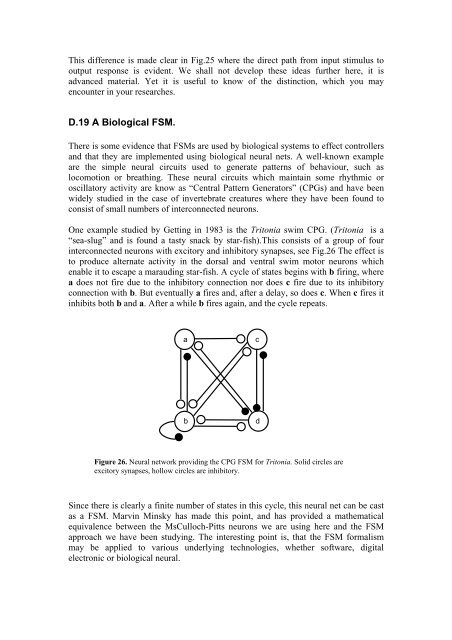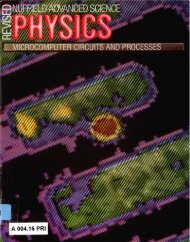Chapter D Finite State Machines
Chapter D Finite State Machines
Chapter D Finite State Machines
- No tags were found...
You also want an ePaper? Increase the reach of your titles
YUMPU automatically turns print PDFs into web optimized ePapers that Google loves.
This difference is made clear in Fig.25 where the direct path from input stimulus tooutput response is evident. We shall not develop these ideas further here, it isadvanced material. Yet it is useful to know of the distinction, which you mayencounter in your researches.D.19 A Biological FSM.There is some evidence that FSMs are used by biological systems to effect controllersand that they are implemented using biological neural nets. A well-known exampleare the simple neural circuits used to generate patterns of behaviour, such aslocomotion or breathing. These neural circuits which maintain some rhythmic oroscillatory activity are know as “Central Pattern Generators” (CPGs) and have beenwidely studied in the case of invertebrate creatures where they have been found toconsist of small numbers of interconnected neurons.One example studied by Getting in 1983 is the Tritonia swim CPG. (Tritonia is a“sea-slug” and is found a tasty snack by star-fish).This consists of a group of fourinterconnected neurons with excitory and inhibitory synapses, see Fig.26 The effect isto produce alternate activity in the dorsal and ventral swim motor neurons whichenable it to escape a marauding star-fish. A cycle of states begins with b firing, wherea does not fire dueto the inhibitory connection nor does c fire due to its inhibitoryconnection with b. But eventually a fires and, after a delay, so does c. When c fires itinhibits both b and a. After a while b fires again, and the cycle repeats.acbdFigure 26. Neural network providin g the CPG FSM forTritonia. Solid circles areexcitory synapses, hollow circles are inhibitory.Since there is clearly a finite number of states in this cycle, this neural net can be castas a FSM. Marvin Minsky has made this point, and has provided a mathematicalequivalence between the MsCulloch-Pitts neurons we are using here and the FSMapproach we have been studying. The interesting point is, that the FSM formalismmay be applied to various underlying technologies, whether software, digitalelectronic or biological neural.











